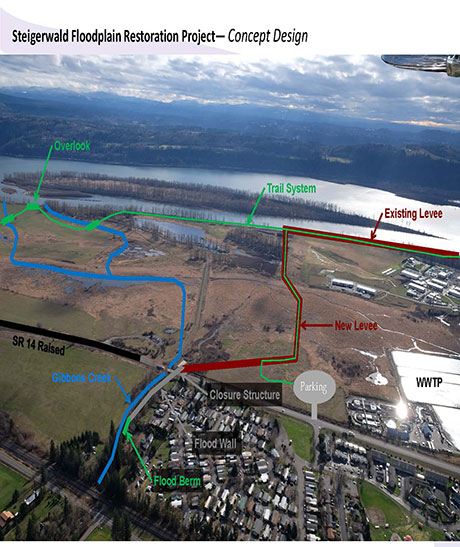Construction begins at Steigerwald Lake National Wildlife Refuge on June 1 as part of the largest habitat restoration project along the lower Columbia River to date. Salmon, lamprey, waterfowl, and many other species will benefit when a vast historic floodplain is reconnected to the Columbia River, providing fish with unobstructed passage to newly restored, high quality habitat in an area of the river where such habitat is lacking.
The multi-year Steigerwald Reconnection Project is a collaboration led by the Lower Columbia Estuary Partnership, U.S. Fish and Wildlife Service, and Port of Camas-Washougal to reconfigure the existing Columbia River levee system to reduce flood risk, reconnect 965 acres of Columbia River floodplain, and increase recreation opportunities at the Refuge.
Construction this year includes raising a portion of SR-14 above the 500 year flood level, realigning a portion of Gibbons Creek, relocating the Refuge parking lot, and beginning construction of setback levees.
These setback levees will better protect the Port of Camas-Washougal Industrial Park, the City of Washougal wastewater treatment plant, and private residences from flooding.
Next year, the new setback levees will be completed, and more than 2 miles of the existing Columbia River levee will be removed, thereby reconnecting the Columbia River to its historic floodplain for the first time in generations.
The Refuge will be closed to visitors for lengthy periods while construction occurs. Beginning June 1, the existing Refuge parking lot will permanently close.
During this time, visitors can access the dike trail from Captain William Clark Park east to the Fish Ladder, however the Refuge’s interior trails will not be accessible to the public (this includes no access to the Gibbons Creek Wildlife Art Trail that connects to the dike trail near Redtail Lake and the Refuge’s seasonal trail that connects to the dike trail just east of the fish ladder). The entire Refuge (including the dike trail, beginning just east of Index Street) will be closed to the public from July 6 through October 2 of this year and again beginning in April 2021.
Travelers and local residents may also experience intermittent lane closures on SR-14 from June 1 until September 30 during construction on SR-14.
Last year, the project broke ground when crews anchored 84 large wood habitat structures in the Gibbons Creek alluvial fan and began revegetation efforts. Next year, in addition to the levee work, crews will restore 115 acres of wetland habitat, build a larger parking lot and restrooms, and add an additional mile of trail to the existing network. Once state and local guidelines allow, volunteers and students will engage in planting native trees and shrubs to help revegetate the project.
An estimated 503 family wage jobs will be created through the project and it will bring an estimated $67.4 million to the Southwest Washington economy. Local firms Rotschy, Inc. of Vancouver and LKE Corporation of Washougal will construct the project.
“This is an extraordinary project – the largest salmon recovery restoration project in the region that also solves multiple community needs,” said Debrah Marriott, Executive Director of the Estuary Partnership. “Our restoration team has worked extensively with the community over the last several years, to make this massive habitat restoration – flood management – recreation – student and volunteer – economic stimulus – recreation project, their project. It shows the power of working together.”
“It is exciting to see the Steigerwald Reconnection Project become a reality,” said Eric Anderson of the U.S. Fish and Wildlife Service. “Partners have collaborated on this project for nearly 7-years. The shared funding, time, and talents of our partners have moved this project from concept to construction. Upon completion this large scale restoration project will provide healthy habitat to support native wildlife into the future. Additionally, the new trail system will create a user experience that invites visitors to reconnect and engage with the restored landscape.”
The project is funded by Bonneville Power Administration, Washington State Department of Ecology’s Floodplains by Design Program, the National Fish and Wildlife Foundation, U.S. Fish and Wildlife Service, and the One Tree Planted Foundation.
More information can be found at www.refuge2020.info/steigerwald-floodplain-restoration or www.estuarypartnership.org/steigerwald
The Estuary Partnership was established in 1995 by the Governors of Washington and Oregon and the U.S. EPA to provide regional coordination, to advance science, and to get on‐the‐ground results in the lower Columbia River and estuary. It is a collaborative program of the states of Oregon and Washington, federal agencies, tribal governments, non‐profit organizations, businesses and economic interests, and citizens. The Estuary Partnership restores and protects habitat, improves water quality and reduces pollution, and provides information about the river. The lower Columbia River and estuary is an “Estuary of National Significance,” one of only 28 National Estuary Programs in the nation. The U.S. EPA administers the National Estuary Program, created in the 1987 amendments to the Clean Water Act. The Estuary Partnership is a 501(c)3 non‐profit corporation. For more information, visit www.estuarypartnership.org.

